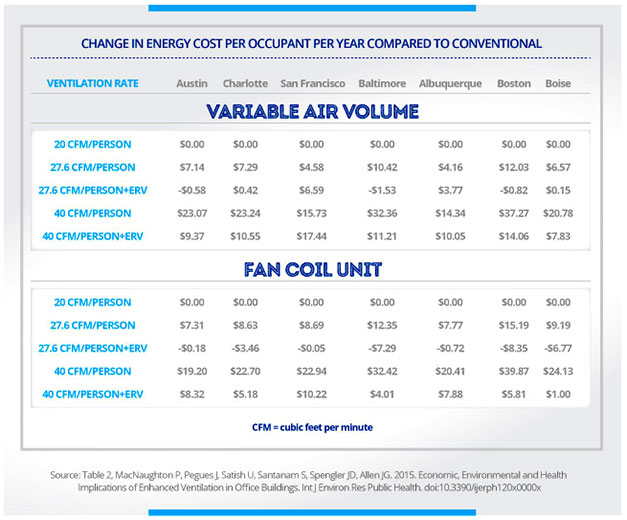Study proves value of good indoor air quality
18th November 2015USA: A new study has found that the energy costs required to double the ventilation rate in typical office buildings can be more than offset by increased worker productivity.
The research found that doubling the ventilation rate would put between $14 and $40 per person per year on the average energy bill, but result in as much as a $6,500 equivalent in improved productivity per person. When energy-efficient technologies are utilised, the study found the energy costs to be even lower.
The research, titled Economic, Environmental and Health Implications of Enhanced Ventilation in Office Buildings, was conducted by the Harvard TH Chan School of Public Health’s Center for Health and the Global Environment, SUNY Upstate Medical, Syracuse University and Carrier. The study was supported by United Technologies and its UTC Climate, Controls & Security business.
 The report was published today in the International Journal of Environmental Research and Public Health’s special issue Indoor Environmental Quality: Exposures and Occupant Health, and builds on the recently released Impact of Green Building on Cognitive Function study by the same research team. Also known as the COGfx study, the research found cognitive function test scores improved 101% in green building environments with enhanced ventilation compared to conventional building environments.
The report was published today in the International Journal of Environmental Research and Public Health’s special issue Indoor Environmental Quality: Exposures and Occupant Health, and builds on the recently released Impact of Green Building on Cognitive Function study by the same research team. Also known as the COGfx study, the research found cognitive function test scores improved 101% in green building environments with enhanced ventilation compared to conventional building environments.
“This study shows there is no longer a tradeoff between energy efficiency and indoor environmental quality – both can be achieved together to accelerate the green building movement,” said John Mandyck, UTC chief sustainability officer. “Readily available, energy efficient technology can turn office buildings into human resource tools that improve the health and productivity of the people inside.”
Researchers studied three indoor environments achieved by four different HVAC system strategies across seven US cities representative of different climate zones: Austin, Texas; Charlotte, North Carolina; San Francisco, California; Baltimore, Maryland; Albuquerque, New Mexico; Boston, Massachusetts; and Boise, Idaho.
In each case, the team selected the Department of Energy Medium Office Prototype (a 53,000ft², three-storey building with more than 260 occupants) as the standard; used state average utility prices for each city; and referenced salary data obtained from the Bureau of Labor Statistics.
The three indoor environments were: standard ventilation at 20ft3/min of outdoor air per person, the green condition used during the COGfx study; 30% higher ventilation than ASHRAE Standard 62.1-2010, which is required to obtain a US Green Building Council LEED credit for enhanced ventilation, equivalent to 27.6ft³/min of outdoor air per person; and 40ft³/min of outdoor air per person, the enhanced green condition used during the COGfx study.
The HVAC systems were VAV and fan coil units, with both systems evaluated with and without an energy recovery ventilator.
“It’s important to note that our study provides a conservative estimate of the benefits of enhanced ventilation because we focused solely on cognitive function. The public health literature indicates that we would expect many co-benefits of increasing ventilation rates, such as reduced absenteeism due to illness, which has clear impacts on productivity,” said Piers MacNaughton, doctoral candidate at the Harvard TH Chan School of Public Health and project manager of the COGfx study.
“This study makes the case that new building construction should design for ventilation rates above current code-mandated levels and include ERVs, and existing buildings should investigate retrofitting with increased ventilation rates and ERVs – both to improve occupant productivity and reach building sustainability goals,” said Jim Pegues, engineering fellow and study researcher, UTC Climate, Controls & Security. “For building owners interested in replicating the analysis of energy cost and environmental impact for their own buildings, the modelling is straightforward and we believe could be used by owners for all building types.”
The full study can be found at www.TheCOGfxStudy.com.
Related stories:
Good IAQ improves workers’ response – November 4, 2015
USA: Improved indoor environmental quality doubled participants’ scores in cognitive function tests, according to a new study. Read more…








